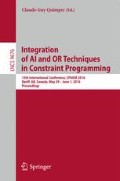Abstract
Globally, flooding is the most frequent among all natural disasters, commonly resulting in damage to infrastructure, economic catastrophe, and loss of life. Since the flow of water is influenced by the shape and height of topography, an effective mechanism for preventing and directing floods is to use structures that increase height, e.g., levees and sandbags. In this paper, we introduce the Optimal Flood Mitigation Problem (OFMP), which optimizes the positioning of barriers to protect critical assets with respect to a flood scenario. In its most accurate form, the OFMP is a challenging optimization problem that combines nonlinear partial differential equations with discrete barrier choices. The OFMP requires solutions that combine approaches from computational simulation and optimization. Herein, we derive linear approximations to the shallow water equations and embed them in the OFMP. Preliminary results demonstrate their effectiveness.
Access this chapter
Tax calculation will be finalised at checkout
Purchases are for personal use only
Notes
- 1.
This is different from evacuation settings, in which the flood arrival time at various locations is critical information.
References
Brekelmans, R., den Hertog, D., Roos, K., Eijgenraam, C.: Safe dike heights at minimal costs: the nonhomogeneous case. Oper. Res. 60(6), 1342–1355 (2012). http://pubsonline.informs.org/doi/abs/10.1287/opre.1110.1028
Che, D., Mays, L.W.: Development of an optimization/simulation model for real-time flood-control operation of river-reservoirs systems. Water Resour. Manage. 29(11), 3987–4005 (2015). http://link.springer.com/10.1007/s11269-015-1041-8
Chertock, A., Cui, S., Kurganov, A., Wu, T.: Well-balanced positivity preserving central-upwind scheme for the shallow water system with friction terms. Int. J. Numer. Methods Fluids 78(6), 355–383 (2015). http://dx.doi.org/10.1002/fld.4023
Colombo, R.M., Guerra, G., Herty, M., Schleper, V.: Optimal control in networks of pipes and canals. SIAM J. Control Optim. 48(3), 2032–2050 (2009). http://epubs.siam.org/doi/abs/10.1137/080716372
Downton, M.W., Miller, J.Z.B., Pielke, R.A.: Reanalysis of U.S. National Weather Service flood loss database. Nat. Hazards Rev. 6(1), 13–22 (2005). http://ascelibrary.org/doi/10.1061/(ASCE)1527-6988(2005)6%3A1(13)
Judi, D., Tasseff, B., Bent, R., Pan, F.: LA-UR 14–21247: topography-based flood planning and optimization capability development report. Technical report, Los Alamos National Laboratory (2014)
Kalyanapu, A.J., Shankar, S., Pardyjak, E.R., Judi, D.R., Burian, S.J.: Assessment of GPU computational enhancement to a 2D flood model. Environ. Model. Softw. 26(8), 1009–1016 (2011). http://dx.doi.org/10.1016/j.envsoft.2011.02.014
Mei, X., Decaudin, P., Hu, B.G.: Fast hydraulic erosion simulation and visualization on GPU. In: 15th Pacific Conference on Computer Graphics and Applications, Maui, Hawaii, pp. 47–56 (2007)
Pielke, R.A., Downton, M.W.: Precipitation and damaging floods: trends in the United States, 1932–97. J. Clim. 13(20), 3625–3637 (2000). http://journals.ametsoc.org/doi/abs/10.1175/1520-0442(2000)013%3C3625%3APADFTI%3E2.0.CO%3B2
Proverbs, D., Mambretti, S., Brebbia, C., Wrachien, D.: Flood Recovery Innovation and Response III. WIT Press, Southampton (2012)
Rydlund, P.H.: Peak discharge, flood profile, flood inundation, and debris movement accompanying the failure of the upper reservoir at the Taum Sauk pump storage facility near Lesterville, Missouri. Technical report (2006)
Acknowledgments
We gratefully acknowledge our early discussions on flood modeling and mitigation with Feng Pan and David Judi at Pacific Northwest National Laboratory [6]. The work at LANL was carried out under the auspices of the National Nuclear Security Administration of the U.S. Department of Energy at Los Alamos National Laboratory under Contract No. DE-AC52-06NA25396.
Author information
Authors and Affiliations
Corresponding author
Editor information
Editors and Affiliations
Rights and permissions
Copyright information
© 2016 Springer International Publishing Switzerland
About this paper
Cite this paper
Tasseff, B., Bent, R., Van Hentenryck, P. (2016). Optimal Flood Mitigation over Flood Propagation Approximations. In: Quimper, CG. (eds) Integration of AI and OR Techniques in Constraint Programming. CPAIOR 2016. Lecture Notes in Computer Science(), vol 9676. Springer, Cham. https://doi.org/10.1007/978-3-319-33954-2_26
Download citation
DOI: https://doi.org/10.1007/978-3-319-33954-2_26
Published:
Publisher Name: Springer, Cham
Print ISBN: 978-3-319-33953-5
Online ISBN: 978-3-319-33954-2
eBook Packages: Computer ScienceComputer Science (R0)

